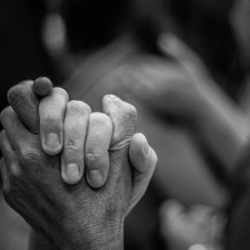Welcome readers! Please subscribe through the buttons at the right if you enjoy this post.

This week let’s look at another text in the gospels that some Christians use when they object to Jesus’ teaching of nonviolence:
“Do not suppose that I have come to bring peace to the earth. I did not come to bring peace, but a sword.” (Matthew 10:34)
Christians have used this passage to justify picking up the sword to “enlarge the Kingdom.” When you read the context of this passage, though, that seems more a determined, intentional effort to interpret Jesus’ words in any other way than as part of the ethic of nonviolence Jesus taught. Mahatma Gandhi reportedly said, “The only people on earth who do not see Christ and his teachings as non-violent are Christians.” There was a time in my life, too, when I genuinely felt that Jesus’ teachings on non-violence were tangential, but I must confess that I believe I was wrong. I have begun to see that Jesus’ teachings on non-violence are central to the kind of human community Jesus envisioned his society could grow into. That vision involved surviving any liberation attempt against Roman oppression, but it wasn’t just about individuals surviving. Nonviolence was also to characterize the community’s quality of life, as well.
In Matthew’s gospel, Jesus continues the above passage with these words:
“For I have come to turn ‘a man against his father, a daughter against her mother, a daughter–in–law against her mother–in–law—your enemies will be the members of your own household.’ Anyone who loves their father or mother more than me is not worthy of me; anyone who loves a son or daughter more than me is not worthy of me. Whoever does not take up their cross and follow me is not worthy of me.” (Matthew 10:35-38)
What did Jesus mean by the statement that He came to bring a sword? Did he want his followers to take up the sword? Or was he saying that the social changes he came to bring would quite likely bring pushback from those empowered with a sword?
The Greek word translated as sword in these verses is machaira. It can be translated figuratively to denote strife or warfare. I do not believe Jesus is saying that those who follow Him should engage in violent warfare in “Jesus’ name” as Christians have historically done. I see them instead as saying that those who chose to follow him should expect to receive strife or warfare for standing up against societal injustice and calling for change. In Jesus’ statement, the strife being created is between parents and children. This is significant, because it meant the power and authority within the social structures of the family being challenged. John Dominic Crossan comments on this:
“Imagine the standard Mediterranean family with five members: mother and father, married son with his wife, and unmarried daughter, a nuclear extended family all under one roof. Jesus says he will tear it apart. The usual explanation is that families will become divided as some accept and others refuse faith in Jesus. But notice where and how emphatically the axis of separation is located. It is precisely between the generations. But why should faith split along that axis? Why might faith not separate, say, the women from the men or even operate in ways far more random? The attack has nothing to do with faith but with power. The attack is on the Mediterranean family’s axis of power, which sets father and mother over son, daughter, and daughter-in-law. That helps us to understand all of those examples. The family is society in miniature, the place where we first and most deeply learn how to love and be loved, hate and be hated, help and be helped, abuse and be abused. It is not just a center of domestic serenity; since it involves power, it invites the abuse of power, and it is at that precise point that Jesus attacks it.” (in Jesus: A Revolutionary Biography, p. 67)
Jesus then states that His followers are not to take up the sword in response to those who wield the sword against them; rather, Jesus’ followers are to take up “the cross.” This is a far cry from Jesus encouraging his followers to practice “justified violence.” Instead this is a call to keep standing up against abuse of power and promote a more egalitarian distribution of power even if you are being threatened with a cross for doing so. (See A Primer on Self-Affirming Nonviolence, Part 4.)
Consider this passage about Jesus not bringing peace but a sword through the lens of Dr. Martin Luther King Jr. In 1955, King responded to an accusation that he was “disturbing the peace” through his activism during the Montgomery Bus Boycott. King wrote, “True peace is not merely the absence of tension: it is the presence of justice.”
Jesus was not about peace-keeping but peace-making. He was not about keeping the peace, not disturbing the status quo, but about calling for justice, the justice that in the Jewish tradition was to be the foundation of peace. Peace was not the absence of conflict but about the fruit of a distributive, societal justice:
“Of the greatness of his government and peace there will be no end . . . establishing and upholding it with justice and righteousness . . .” (Isaiah 9:7)
“The way of peace they do not know; there is no justice in their paths.” (Isaiah 59:8)
“Everyone will sit under their own vine and under their own fig tree, and no one will make them afraid.” (Micah 4:4)
An example in the synoptic gospels that illustrate Jesus’ willingness to disturb the peace is his final entry into Jerusalem. He disrupted the Temple activity in protest of the economic system’s exploitation and oppression of the poor.
In Mark 12:40, Jesus states how those benefiting from the system “devour widows’ houses” while “for a show make lengthy prayers.” Immediately Mark then gives an example of a poor widow paying the Temple tax (see Mark 12:41-13:2).
In Mark, Mathew, and Luke we read of Jesus entry into Jerusalem and his temple protest. My favorite is Mark’s version:
“They went and found a colt outside in the street, tied at a doorway. As they untied it, some people standing there asked, ‘’What are you doing, untying that colt?’ They answered as Jesus had told them to, and the people let them go. When they brought the colt to Jesus and threw their cloaks over it, he sat on it. Many people spread their cloaks on the road, while others spread branches they had cut in the fields. Those who went ahead and those who followed shouted, ‘Hosanna! Blessed is he who comes in the name of the Lord! Blessed is the coming kingdom of our father David! Hosanna in the highest heaven!’ Jesus entered Jerusalem and went into the temple courts. He looked around at everything, but since it was already late, he went out to Bethany with the Twelve.” (Mark 11:4-11)
The events of entering Jerusalem and overturning the tables in the Temple seem to have originally been planned as one combined event. Yet by the time Jesus gets to the temple, it is “already late” and most of the people there have returned home. For a demonstration to be effective there have to be people to witness the demonstration. You can’t protest and raise awareness without witnesses, and “business as usual” has to actually take place for one to disrupt.
So Mark’s story states that Jesus went back to Bethany (most likely the home of Martha, Mary and Lazarus) and stayed there for the night, then returned the next day to finish his protest.
Ultimately I believe Jesus was seeking the peace that comes through everyone having enough not only to survive but also to thrive. A world where no one has too much while others don’t even have enough. Yet to do that, we must be willing to disrupt and disturb the status quo. Jesus did so nonviolently, yet his actions were disruptive nonetheless. And yes, it did bring a “sword.” Before the week of his protest was over, he was crucified for the economic and political implications of his Temple disruption and the ever growing crowd of Jewish working and peasant poor who were following him. His action of disturbing the peace brought the sword as he’d taught it would. This is, I believe, a much more life-giving interpretation of our passage then the teaching that Christians should not oppose violence.
Christian history would look very different if Christians had refused to take up the sword in Jesus’ name. The world, too, might even look very different had the church not abandoned Jesus’ teachings on nonviolence. Today, however, Christianity stands as the world religion with the most violent history. It is to the end of repairing that damage, especially to marginalized communities, that Christians must work toward today.
Again, there is much to contemplate this week.
“Do not suppose that I have come to bring peace to the earth. I did not come to bring peace, but a sword.” (Matthew 10:34)













